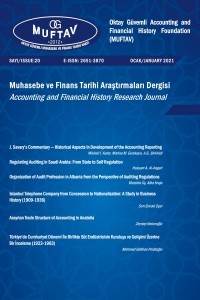Accounting, From Classic Recognitions to Great Expectations
There are over 50 years, in 1951, the theme of the 11th Congress of the Federation of Chief Executive Accountants held in Bordeaux on 26, 27, May 28, was notably about: “Accounting, what it is, what it should be, what it can become. “ It seems that this problem is ongoing. When considering accounting in its deepest roots, the more conventional double-base or its latest developments based on international standards, we can ask whether the accounting followed a parallel course to the other sciences and techno-science or if it situated behind. Despite modern conceptual frameworks and full of good intentions but the narrow limits, can we not discuss the Aristotelian framework of accounting to provide a frame of reference wider and more effective? It has long been opposed the hard sciences and social sciences. In the field of hard sciences, we use the mathematical language that can make forecasts, and from this mechanical forecasting, the results are consistent with what was expected. There is a correspondence between the structure of mathematical language and structure of technical problems. On the contrary, in the social sciences, there is no direct connection between language and facts and it’s never easy to predict and to equate behaviors and emotions of humans. In recent years, researchers have proposed ways, highways, on which future accounting could find its path. In a book about the time, E. Klein opposes the space that is the brand and demonstrates the power of man and time which is the mark of his weakness. Time is also the mark of a certain weakness of accounting. The space of accounting, by contrast, presents many opportunities. Accounting standard is almost like Greek tragedy with unity of time, unity of place, unity of action. The multiplicity of actions, complexity, leads to rupture of the unity of time. The accounting system of thought has some way to do, if only because many authors do not distinguish between the ontological status of the nature of income and capital, the epistemological question of the representation, and methodological question of the extent of income and capital. But if the concepts are not clearly highlighted and whether their measurement presents difficulties, we cannot even say they do not exist. In the future, once the sorting is actually done between theories and approaches multi paradigmatic, perhaps it will be easier to distinguish the positive scheme of pure science and pragmatic representation of the subject that professional and academic people are trying to make in their books and in their annual accounts.
Keywords:
Epistemology, Space, History of Accounting, Pragmatic Representations, Social Sciences, Systemsthinking–Ontology, Methodology, AccountingTheories, Positive Theory Time,
- ISSN: 2146-4928
- Yayın Aralığı: Yılda 2 Sayı
- Başlangıç: 2011
- Yayıncı: Oktay Güvemli Muhasebe ve Finans Tarihi Vakfı (MUFTAV)
Sayıdaki Diğer Makaleler
Osmanlı'da Devlet Muhasebesi Mesleğinin Özellikleri
Prof. Dr. Oktay Güvemli'nin Muhasebe Tarihi Çalışmalarını Anlatan Kitabı
TÜRKİYE’DEKİ MUHASEBE TARİHİ AKTİVİTELERİ JAPON BASININDA
Çift Yanlı Kayıt Yöntemin Tarihçesinin Anlatımı - 1933
Osmanlı Arşiv Belgelerinin Günümüze Ulaşmasının Nedenleri: Kâğıt, Mürekkep ve Cilt Özellikleri
CUMHURİYETİN 90. YILINA ARMAĞAN CUMHURİYET TARİHİNİN MUHASEBE VE FİNANS KİTAPLARI ENVANTER ÇALIŞMASI
